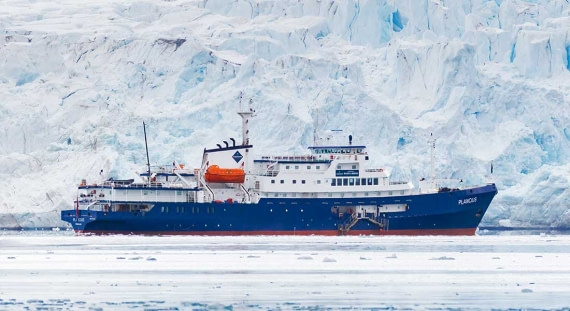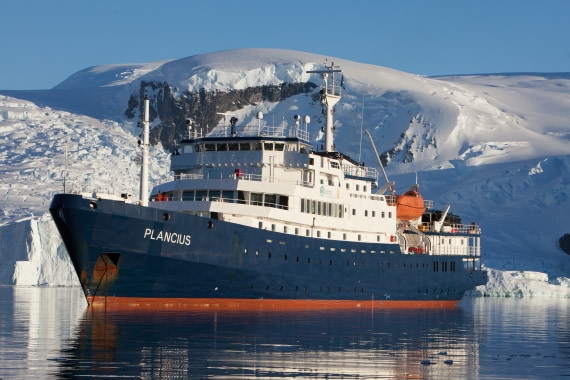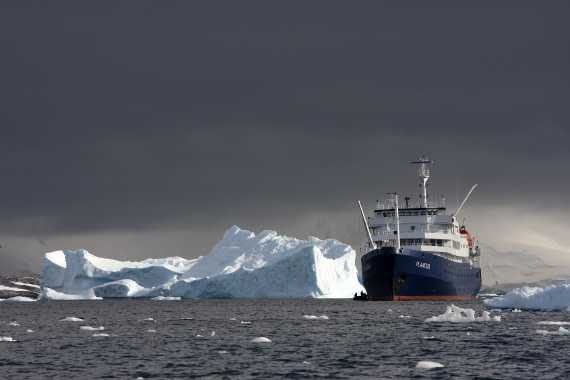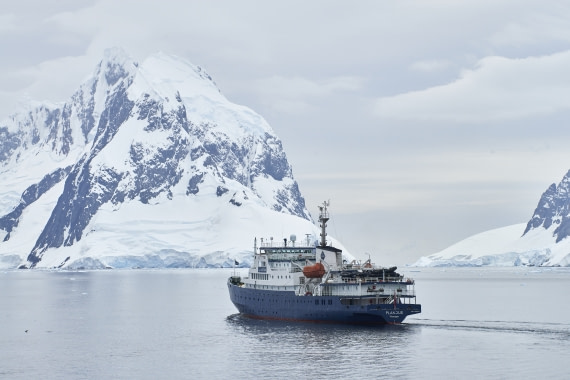| Fecha: |
10.02.2025 |
| Posición: |
62°41.2’S / 060°49.3’W |
| Viento: |
3kt |
| Clima: |
Overcast |
| Temperatura del Aire: |
+7 |
Ali woke us up this morning, to another new sight, as we approached Livingston Island in the South Shetlands. We had sailed through the night from the Antarctic Peninsula and arrived to a pleasant temperature, evidence of a north heading. It was hard to tell from the deck of the boat what was in store for us, but we were quickly grinning from ear to ear when we arrived at the beach. We disembarked at Elephant Point on a beach of black volcanic sand and rock. At first glance, it seemed a little gloomy, but the site was nonetheless teeming with life. Hundreds of Gentoo penguin chicks formed rambunctious groups along the beach. Other more imposing occupants shared the space, male elephant seals. Some lounged in small groups on the beach, and some had even gathered higher up on an embankment. Their wide tracks could be seen in the vegetation as their large bodies compress anything underneath them.
Young male elephant seals have an increasingly prominent nasal appendage as they grow older. A few large territorial males weighing several tonnes could be seen battling it out in the water. At other times, particularly in spring during the breeding season, the males compete to gain access to females and form their harem of several dozen partners. Although they are very agile in the water, they don't seem to be very well adapted to the terrestrial environment. Nonetheless, it is impressive to observe their ability to move very quickly in a crawling motion. Between the rocks, a male fur seal was resting, occasionally poking his head out to take a peek at us. At the end of the route, we had a view of the glacier on Livingston Island and a beach littered with penguins. Some Brazilian scientists had set up camp for the summer season and they came to meet us to exchange greetings. After saying goodbye to the young Gentoo penguins, we re-embarked for lunch and the sailed to Deception Island.
This island of Deception Island is unique in that it is one of only three offshore calderas in the world. Created by volcanic activity several thousand years ago, the island was originally a conical volcano that collapsed at its center during a violent eruption to form the caldera that is now navigable. Entering the caldera through Neptune's bellows is impressive, as the seabed at this point forces the ship to approach the cliffs. A small colony of chinstrap penguins was stationed on the slopes of the volcano.
Once inside, we could see the remains of the buildings of an old whaling station in the distance, as well as fumaroles formed by the resurgence of hot water. The last eruption was in 1969. At that time, the scientific bases located in the caldera had to be evacuated in a hurry. Three Argentinian and Chilean bases are still regularly occupied for scientific activities.
We then disembarked for our last Antarctic activity in Telefon Bay at the bottom of the crater. It was more like being on the moon than in Antarctica, and the sight surprised many of us. The ground is black, made up of cooled lava and scories; nothing like what we had seen on our trip so far. We climbed up onto the rim of a small secondary crater to take in the fantastic view. The fresh snow that had fallen the day before contrasted with the black rocks of the volcano.
A beautiful and astonishing last stage in our journey to Antarctica. To round off this adventure, the bravest among us were able to jump into the water at 1°C for a polar bath! The hardest part was undoubtedly getting dressed once we'd cooled off. We were soon back in the Plancius for a hot shower before the evening recap.
Ali gave us a presentation on the sea conditions over the next few days, as we were about to start crossing the Drake Passage that very evening. We also had a presentation on the elephant seals we had seen in the morning, followed by some advice on taking photos, and finally some information on hypothermia.
It was a busy day, full of contrasting landscapes, and plenty of excitement on our last day in Antarctica.
KAYAK
Morning: An Unforgettable Encounter at Elephant Point
Low-hanging clouds shroud the sky, casting a mysterious aura over this rugged volcanic landscape. Here, dark cliffs contrast starkly with a massive glacier that plunges into the sea, creating an almost Icelandic atmosphere. Elephant Point is aptly named—on the beach, large elephant seals lie in scattered groups, their massive forms visible from afar. But before we can even focus on them, an unexpected visitor makes its presence known.
A leopard seal circles our zodiac, curious and elusive. We wait for it to move away before launching our kayaks, but the moment we hit the water, it returns. Julien, our guide, immediately gives the instructions: we form a raft, bringing all kayaks side by side to ensure stability and minimize the chances of an overly close encounter. The leopard seal glides around us, disappears beneath the surface, then resurfaces just a few meters ahead, its piercing eyes locking onto us. Time stretches. Some paddlers grip their kayaks a little tighter, hearts pounding. Julien remains calm, reassuring us, explaining that we are in an ideal position to observe this fascinating predator without risk. Finally, Brian, handling safety from the zodiac, deploys a well-practiced trick—creating bubbles with the engine, drawing the seal’s curiosity away from us. Slowly, it moves off, resuming its exploration of the area. We can now continue our journey.
Paddling Among Elephant Seals
We paddle gently toward the shore, where we can observe the elephant seals up close. The contrast is striking—these massive, sluggish giants groan and snooze on the sand, moving awkwardly, while we just encountered a sleek, agile predator. Continuing our route, we weave between rocky outcrops. The environment is raw, wild, entirely different from our previous landscapes. We carefully follow Julien’s lead to avoid zones where waves crash against the rocks and choose the safest paths through the shifting currents.
As we progress, we reach the southern coastline, where scattered islets rise from the icy waters. The atmosphere is unique, almost prehistoric, as if this place has remained unchanged for millennia.
A More Challenging Return
For the return journey, we opt for a more direct route, avoiding the intricate maze of rocks. However, this exposes us to stronger winds and ocean swell. The kayaks bob on the waves, challenging our balance and technique. This final stretch feels like a culmination of everything we havelearned. It demands concentration but also provides pure exhilaration—a dynamic, flowing paddle through the open sea. Finally, we reach the zodiacs, still processing the extraordinary morning. The encounter with the leopard seal will stay with us—a moment both intense and intimate, a glimpse into the unpredictable and untamed wildlife of Antarctica.
Afternoon: Paddling Inside a Volcano at Deception Island
In the afternoon, we set course for Deception Island, one of the most legendary sites in the South Shetlands. Here, the earth still smolders in places, a reminder of the volcanic activity that has shaped this eerie landscape. The island, with its massive caldera, feels like another world—a sea-filled crater enclosed by dark cliffs, a stark and almost lunar setting. We launch from Telephone Bay, in the northern part of the caldera. The water is calm at first, but soon, the wind picks up. Instead of fighting it, we decide to use it to our advantage—paddling with the wind at our backs, letting the icy air push us in the right direction.
Gliding Through a Volcanic Landscape
The contrast is striking. Gone are the towering glaciers; instead, we paddle along rugged, mineral-rich slopes tinted black and ochre. The island’s sheer cliffs plunge directly into the sea, giving us the surreal sensation of navigating through a forgotten world, where fire once ruled instead of ice.
Propelled by the wind, we reach a small, sheltered lagoon. Here, the water is perfectly still, protected from the gusts. The silence is profound, broken only by the occasional cries of seabirds circling above. We pause to take in this hidden sanctuary, an improbable oasis within the volcanic crater. But outside, the wind continues to strengthen, stirring up the waves. The idea of paddling back against it quickly becomes unrealistic.
We make the safe choice: regrouping and returning to the Plancius by zodiac. As we board, we meet the rest of the group, who are preparing for an entirely different challenge—the Polar Plunge. Some of us, still buzzing from the paddle, decide to join. The thought of diving into Antarctic waters, inside an active volcano, is irresistible. The moment we hit the freezing water, a shockwave runs through our bodies, every nerve alive. It lasts only seconds, but the exhilaration lingers.
As we leave Deception Island behind, we know that this final kayaking experience has been unlike any other; navigating through an active volcano, embracing the elements, and finishing with a plunge into the frigid sea. A fitting end to our intense Antarctic exploration.














